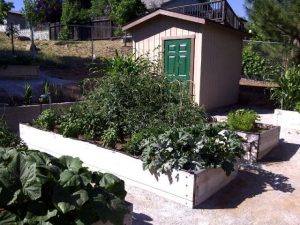Repurposing. Recycling. We are all looking for new ways to use or re-use things in our lives. Clothing, furniture, tin foil, car oil, plastic milk jugs – all have a second life awaiting them. We know that many things in the garden may be used for compost for our plants but is there something more?
The absolute, very best compost for your garden is created with vermiculture or worm composting. Worm castings contain plant hormones that are not present in any other fertilizer or commercial compost mix. Worm castings are able to go right into your beds and have a higher NPK rating than compost. Worms are easy to maintain (with a few hints) and eat things that are ending up in our landfills.
To build your own worm bin use a shallow plastic bin. Worms can sense light (they have no eyes) so use a dark colored bin. The top half of the bin should have 1/4 inch holes (use a drill) for air and a hole at the bottom for drainage. If you buy a second bin to sit the first bin into, you can have a place for the moisture to drain off into. Your bin should be 10 to 16 inches deep and have a snug fitting lid. Choose a place for your bin that does not get too hot or too cold so your worms are comfortable and happy.
Your worms should be red wigglers not night crawlers or earthworms. Red wigglers live in the duff layers of the forest. Your worms will prefer moist conditions but not wet. Red worms are surface feeders so the worm bin should not be too deep. If the bin is too deep the moist materials will pack down forcing all the air out making strong odors and killing your worms. You may purchase worms at a bait shop or order then from the internet.
The bedding material needs to be somewhat like the duff in the forest. Shredded newspaper in long strips that are moistened by using a spray bottle is best. Don’t just dump water in the bin. Worms like to live under lots of moist paper or leaves. They love to be cool and moist, having the leaves or paper adds fiber to their diet and keeps the fruit flies from getting to the food. The paper should be like a damp wrung-out sponge. Fill the bin three quarters full with moist bedding. If the bin becomes too wet, add fresh dry shredded paper to help dry it out.
To feed your worms remember they eat a lot of what we eat. The quickest way for the worms to recycle your food scraps is to grind or chop up the scraps. I would buy a cheap blender to use just for this purpose. Fruits, vegetables, coffee, tea bags, tender young weeds, lawn clippings, fallen leaves, pine needles, and some sawdust. Chopped up and added to the bedding about 1 ½ inch deep will be perfect. Then cover the food with new bedding or even straw to keep out the flies. Also your new family of worms does not have teeth so they need grit- the best is oyster shell fine ground. The worms will use the oyster shell with a very muscular mouth, pharynx, and gizzard to break up the food. Red wigglers eat over half their weight every single day. Don’t add grease, oil, meat, bones, fish, or dairy products to your bin. Also stay away from sawdust from treated or plywood and diseased plant materials. You should monitor the moisture and level of food. Replace the food when it is eaten to about ½ inch in depth. Do not let your bin dry out – that will be the end of your worms.
You will notice a change in the weight of the bin when the worms have filled the bin with castings. When new worms hatch they will be little and white then will darken with age. The ring on the worm is closer to the head than the tail. Please do not cut your worms in half to make two – that is an old wife’s tale. Also worms have a gene that does not allow them to outgrow their home and compete for resources. When you are ready to change out your bin, lay out a tarp and just turn the bin over on to the tarp. The worms will migrate away from the light, towards the tarp and then you may easily remove the layer of castings. Add new bedding; put your worms back in their home and leave the lid off for about 30 minutes so they will migrate back into the bedding away from the light. Don’t forget to provide your 1 ½ inch of food and new moist bedding to the top of the bin. Your new worm castings are fine to use right in the garden immediately. Your bin is usually ready to change out at about 6 months. You will notice the bedding gone and crumbly, brown compost will replace it.
Your worms, with a little care, will be recycling super worms! They will help to use your kitchen scraps and turn them into rich, beautiful plant food. Less in the landfill and more in your pocket book – what a combination!
Julie Silva is a University of California Cooperative Extension Master Gardener of Tuolumne County.



